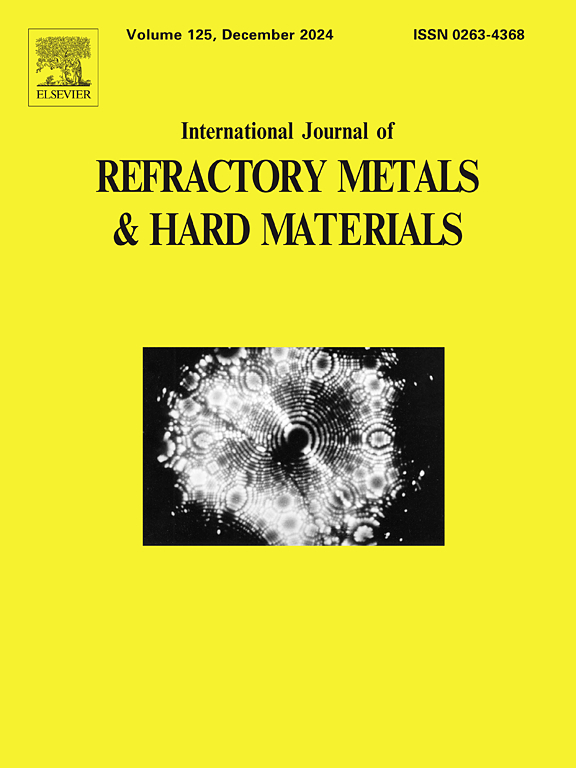纳米钇-分散钨重合金的立体形貌和表征分析:对粒度和Y-W-O复合氧化物形成的影响
IF 4.2
2区 材料科学
Q2 MATERIALS SCIENCE, MULTIDISCIPLINARY
International Journal of Refractory Metals & Hard Materials
Pub Date : 2025-03-26
DOI:10.1016/j.ijrmhm.2025.107162
引用次数: 0
摘要
本研究研究了纳米y₂O₃(0.25-0.75 wt%)的添加量对由93 wt%钨组成的重钨合金(WHA)微观组织演变的影响,其Ni/Co结合剂比固定为9。对Ni、Co和Y₂O₃前驱体粉末进行高能球磨制备氧化分散强化(ODS)基体,并通过低能球磨将其与钨混合。复合粉末经冷等静压固结,1438℃烧结1 h,得到的ODS-W-Ni-Co合金相对密度超过理论值的99.7%。显微组织分析证实形成了W-Y-O复合氧化物相,具有核壳结构和颗粒粗化现象。这些结构转变实质上影响了晶粒形态、生长动力学和整体微观结构的细化。值得注意的是,0.75 wt%的Y₂O₃的加入使固液界面能增加到744.44 MJ/m2,尽管引起了界面能的各向异性分布。高分辨率透射电镜(HR-TEM)显示出半相干γ-Ni/Y₂O₃界面,其晶格失配参数为0.056,表明界面键合增强。这种半相干界面的存在改善了W晶粒与γ-Ni结合相之间的界面强化,有助于微观组织稳定性和潜在的力学性能增强。本文章由计算机程序翻译,如有差异,请以英文原文为准。

Stereographical and characterization analysis of nano yttria-dispersed tungsten heavy alloys: Impact on particle size and Y-W-O complex oxide formation
The present study investigates the influence of nano-Y₂O₃ (0.25–0.75 wt%) additions on the microstructural evolution of a tungsten heavy alloy (WHA) composed of 93 wt% tungsten, with a fixed Ni/Co binder ratio of 9. The precursor powders of Ni, Co, and Y₂O₃ were subjected to high-energy ball milling to produce an oxide-dispersion-strengthened (ODS) matrix, which was subsequently blended with tungsten via low-energy ball milling. The resulting composite powders were consolidated through cold isostatic pressing and sintered at 1438 °C for 1 h. The processed ODS-W-Ni-Co alloys achieved a relative density exceeding 99.7 % of the theoretical value. Microstructural analysis confirmed the formation of a W-Y-O complex oxide phase, characterized by core-shell structures and particle coarsening phenomena. These structural transformations substantially influenced grain morphology, growth kinetics, and overall microstructural refinement. Notably, the incorporation of 0.75 wt% Y₂O₃ increased the solid-liquid interfacial energy to 744.44 MJ/m2, albeit inducing anisotropic interfacial energy distributions. High-resolution transmission electron microscopy (HR-TEM) revealed a semi-coherent γ-Ni/Y₂O₃ interface with a lattice mismatch parameter of 0.056, which is indicative of enhanced interfacial bonding. The presence of this semi-coherent interface is proposed to improve interfacial strengthening between W grains and the γ-Ni binder phase, contributing to microstructural stability and potential mechanical property enhancement.
求助全文
通过发布文献求助,成功后即可免费获取论文全文。
去求助
来源期刊
CiteScore
7.00
自引率
13.90%
发文量
236
审稿时长
35 days
期刊介绍:
The International Journal of Refractory Metals and Hard Materials (IJRMHM) publishes original research articles concerned with all aspects of refractory metals and hard materials. Refractory metals are defined as metals with melting points higher than 1800 °C. These are tungsten, molybdenum, chromium, tantalum, niobium, hafnium, and rhenium, as well as many compounds and alloys based thereupon. Hard materials that are included in the scope of this journal are defined as materials with hardness values higher than 1000 kg/mm2, primarily intended for applications as manufacturing tools or wear resistant components in mechanical systems. Thus they encompass carbides, nitrides and borides of metals, and related compounds. A special focus of this journal is put on the family of hardmetals, which is also known as cemented tungsten carbide, and cermets which are based on titanium carbide and carbonitrides with or without a metal binder. Ceramics and superhard materials including diamond and cubic boron nitride may also be accepted provided the subject material is presented as hard materials as defined above.

 求助内容:
求助内容: 应助结果提醒方式:
应助结果提醒方式:


